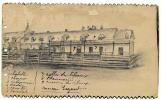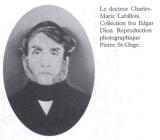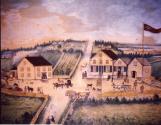2
Fondation of the lazaretto of TracadieAfter many efforts, father Lafrance succeeded in getting 15 lepers transferred from Sheldrake Island to the new lazaretto in Tracadie on July 25th, 1849. A fence was placed around the lazaretto which greatly displeased the lepers because they had no freedom. Fire struck again, much like on Sheldrake Island, destroying the lazaretto on September 4th, 1852. A new lazaretto was built in early October 1853. It now had steel bars around its windows to reduce escape attempts. Father Lafrance was replaced by father Gauvreau in early 1852. He was also an ardent benefactor for the lepers. Doctor Albert Corbett Smith replaced doctor Nicholson when he died in 1866. The new doctor's first action was to have removed all the steel bars from lazaretto's windows. He remained as its doctor until he died in March 1909. He left behind the legacy in the hearts of Tracadie' s population of a greatly devoted man, at once kind and honest and extremely charitable.
Chatham's new bishop, Mgr. James Rogers, passed through Tracadie and went to the lazaretto a few years earlier. The establishment was in a miserable state despite the recent renovations that had been completed.
From that moment on, an ideal took hold in his spirit that would never falter. The day when the fate of the lepers would change greatly was no longer far away.
4
Ferdiand Edmond Gauvreau1806-1875
Ferdinand Edmond Gauvreau was born in Quebec on September 12th, 1806.
He was ordained in 1830.
He came to Tracadie to replace Father Lafrance in January of 1852. His duties for his new parish spanned a territory of sixty or so miles from Neguac to Pokemouche. The duty closest to his heart and his devotion, was the betterment of the fate of the lepers in the lazaretto. He took the iniative of conceiving a project with his bishop, Mgr James Rogers, that would allow nuns to come to the lazaretto to take care of the lepers. The hospitallers of Saint Joseph of Montreal responded favorably to their request. Father Gauvreau went to Montreal himself to visit them and accompany them on their voyage to New Brunswick in 1868.
Being a member of the Bureau of Health, he assured by all means necessary that a part of the funds required for the hospital's upkeep and its staff was available. Father Gauvreau also began the processes and preparations for the construction of a stone church which was completed by his successor, Father Babineau. Father Gauvreau returned to Quebec for health reasons after 19 years of duty. He died in 1875 in the parish of St. Flavien where he served as a priest.
6
Charles Marie Labillois, 1793-1868. The forgotten doctorCharles Marie Labillois was born in Ploërmel in the Morbihan in Brittany, July 8th, 1793. He settled in Saint Joseph de Carleton, Quebec, for unknown reasons in 1816. He married Amélie Meagher on October 4th of the same year. They had eleven children together.
Labillois was the resident doctor at the lazaretto in Tracadie from September to December in 1849. He returned from July until the end of December in 1850. He was never paid for his services. The treatments he administered to the lepers during his stay at the lazaretto were nevertheless effective. As stated by the secretary of the Bureau of Health: "All the lepers concur that their health is better and seem quite happy".
No other doctor had given of himself as much as Dr. Labillois to care for le lepers since the opening of the first lazaretto on Sheldrake Island. No doctor had deserved as much respect and affection from the sick and their families. He treated the lepers risking his own life and health. He received from the French government the medal of Sainte Hélène which had been created by the emperor Napoléon 111 in 1857.
Dr. Labillois died at the age of 76 on September 16th, 1868. He is buried in Saint Joseph de Carlton's parish cemetery in Quebec, Gaspé Peninsula.
8
Robert Gordon, doctor, 1799-1863Doctor Robert Gordon was born of Scottish parents in 1799. He practiced medicine in Bathurst. He was named a member of the County's medical commission to investigate the "disease" that was rampant in the region of Tracadie. He was also responsible for visiting Tracadie's lazaretto which he did a few times a year from 1851 to 1863.
He became a member of the Legislative Assembly of New Brunswick in 1850.
He died in Fredericton in 1863 and is buried in Bathurst.
The lazaretto at the time of doctor Gordon's visits. This painting shows the lazaretto surrended by a fence.
9
Doctor Nicholson James, first specialist doctor in the lazaretto1863
Tracadie, New Brunswick, Canada

10
James Nicholson, doctor, 1834-1865Doctor Nicholson settled in Bathurst in 1856 after having studied at New York University. He arrived in Tracadie as a specialist on May 3rd, 1863. He would be the first resident physician. He believed leprosy to be hereditary and not contagious. He went so far as to inoculate himself with the disease to prove his theory. Dr. Nicholson's presence bought some relief and order among the lepers. He organized outdoor games and exercises to reduce boredom. He subsequently made arrangements to procure a boat for them for fishing and navigating.
He died of phtisis at 31 years of age on April 11th, 1865.He is buried in Chatham's St. Andrew's Church cemetery.
Dom Felix Lajat said of Dr. Nicholson that:"He left a reputation as a devoted man much appreciated by the lepers".
11
Doctor Alfred Corbett Smith, first resident doctor at Tracadie1865
Tracadie, New Brunswick, Canada

12
Alfred Corbett Smith, doctor, 1841-1909Son of James Smith and Suzanne M. Dunn of Bathurst, Albert Corbett was born June 7th, 1841. He married Helen Young, daughter of James Young and Ann Ferguson of Tracadie, May 2nd, 1866. He practiced medicine in Newcastle before being named in charge of the lazaretto in 1965. He had a general practice in Tracadie, an area where he would be the only doctor in a 50 miles radius.
There always was a certain distance between Dr. Smith and the French population in which he worked. Firstly, he was not Catholic and secondly, he was English. It seems that despite this, Tracadie's population remembers him warmly as a very nice man. He was known to diagnose poor people and treat them free of charge. He even paid out of pocket, on occasion, for certain medications. He recognized, like doctors of his time, that leprosy was incurable. He was not interested at that moment in finding a remedy. He seeked to alleviate rather its symptoms. His work was greatly appreciated. He made life easier for his patients. He removed all the bars from the windows. He stayed on until his death in 1909.
Dr. Smith was identified with the hospitallers of Tracadie's work until his death on March 12th, 1909 at 68 years of age. He is buried in the Protestants' cemetery in Tracadie
14
Federal Provincial agreementDoctor Jean Charles Taché visited Tracadie's lazaretto in 1872. He conducted an interesting study of the disease.
He proposed the transfer of administrative responsability of the lazaretto from the provincial to the federal government to facilitate financial aid. Steps were taken and came into effect by the signature of the agreement in presence of the Honourable P. Landry, Minister of Public Works, of father A. Babineau in the name of the Minister of the federal government and of mother Brault and her Council on November 25th, 1880 in Tracadie.




